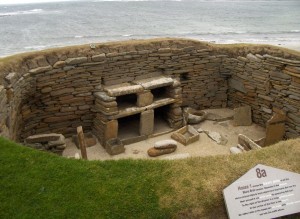Skara Brae House

The settlement at Skara Brae, Orkney dates to the Late Neolithic (3300-2500 BC). The site was discovered in a great sand storm in the mid-19th century and was excavated by Professor Gordon Childe of Edinburgh University in the 1920s (Childe 1931). It is remarkable as it is one of the few settlements dating from this period that are still up-standing. If we visit the site today we can walk around the houses inhabited by people over 5000 years ago, and by doing so potentially understand the way they saw their world.
Why are the houses at Skara Brae important? We are familiar with living in permanent houses, but the Neolithic period is the first time that people began to settle down in permanent houses. In this lecture we will consider what a Neolithic house comprises of (Richards 1991), and why houses were so important for people in this period of prehistory.
Reading
Childe, V.G. 1931.Skara Brae: a Pictish village in Orkney. London: Routledge and Kegan Paul
Richards, C. 1991. Skara Brae: revisiting a Neolithic village in Orkney, in Hanson, W.S. and Slater, E. (eds.) Scottish Archaeology: new perspectives. Aberdeen: Aberdeen University Press
